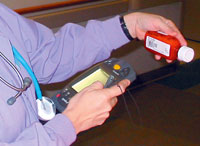AcuScan in all hospital units
By Phyllis Moore
Published in News on February 23, 2004 1:57 PM
New electronic equipment to ensure that patients get accurate doses of medicine is now in use throughout Wayne Memorial Hospital.
The equipment is based on bar codes. The hospital has been putting it into use for more than a year and is the ninth hospital in the nation to introduce it.

News-Argus/Phyllis Moore
Vanessa Murray, an LPN at Wayne Memorial Hospital, demonstrates how information from a medicine bottle is scanned into the AcuScan computer system.
The system is called AcuScan. Before it was introduced, each of the hospital's units already had AcuDose, a medicine dispensing cabinet, but everything was recorded by hand. The AcuScan system allows nurses to scan medication from the cabinet and make sure it is the correct dosage, form, and time to give it.
The system verifies a three-way match of the nurse I.D. badge, the patient's wristband, and the medication. It electronically charts the information into an electronic hand-held device.
The devices are wireless and only work inside the hospital. Antennas have been installed throughout the halls, and to ensure that patients' privacy is not violated, there are several layers of security to access information.
Initially, Wayne Memorial was the only hospital in the region affiliated with the system. The cost for changing over to the technology can be prohibitive for larger hospitals. Wayne Memorial was able to take advantage through a grant from Duke Endowment. The hospital leases 84 of the units.
Pitt Memorial Hospital in Greenville has since also acquired the scanning system.
Pat Wilkerson, Wayne Memorial's patient services administrator, has worked with the system since it was brought to second-floor orthopedics in October 2002. It has been introduced gradually throughout the in-patient departments.
She said the biggest concern at the outset was how it would affect the nursing process of giving medications. The average age of nurses at the hospital is 42, and many were used to a certain routine.
"Any process change evokes high anxiety in any field that you work in," she said. "For nursing, some nurses adapted very quickly to new technology. Other nurses were initially anxious about an additional computer system."
She said it's a complicated process to give medicines and to incorporate it into the nurses' daily practice. Once they learned the software and the equipment, she said, it became easier.
"Nurses used to scanning on one floor would pick up a shift on another unit and would roll their eyes if they learned they didn't have scanners there," she said. "Once they get used to them, they really love them."
She said that each nurse received training about the system and was required to do "shadow time" under an already-trained nurse's supervision. New hires to the hospital are trained as part of their orientation.
Jan Rouse, a nurse for 23 years, said she is not computer-oriented. She said she was apprehensive when the system was announced.
"It took too much time, there were too many kinks in the system and I couldn't take care of my patients the way I like to because I was into the AcuScan all the time," she said.
What turned the tide for her was time and being heard by the administration.
"Letting Pat know what some of our problems were and getting them straightened out" helped, she said.
Ms. Wilkerson said work teams met weekly and now meet monthly, asking for input from the nurses.
"It's been accessible," Ms. Rouse said. "There's just so many of us and so many problems. But it's getting better and the problems are being worked out as we go."
Vanessa Murray, an LPN for 20 years, works on the orthopedics floor. She agreed that there were some challenges to the new system.
"Since we were the first floor to go 'live,' we had to try to work out the kinks," she said. "But after the first four weeks, it was okay."
She said the handheld device allows for easy access in looking up patient information. Often, she said, locating a chart can be difficult as it may be in the hands of a doctor or social worker.
"Every patient on the floor is in there," she said of the system. "I'm able to check off the patients that I have that day and can look up other patients."
Nurse Amanda Sarvis works with surgery and orthopedic patients. She said she liked the scanners from the start and feels they are an improvement for the hospital.
"I think it prevents a lot of errors," she said. "It makes my job easier."
Debbie Phillips, director of adult health services, said it is exciting to be at a hospital with this kind of technology. But AcuScan isn't necessarily a time-saver.
"It's not faster but it's safer from a patient safety perspective," she said.
Stephanie Smith is a charge nurse on the obstetrics floor, which started the system three weeks ago. She said it does take time, but is probably quicker because it checks things for the nurses.
"It's a very efficient system," she said. "You do not have to be depending on a piece of paper. If you fail to give something, it's not going off the screen until it's given.
"On a piece of paper, you can overlook or miss something."
Nurses are encouraged to check the device at least hourly. At the end of the day, a report is printed and added to the patient's chart. When the patient checks out of the hospital, all of the information is included in his medical records.
Ms. Wilkerson said the system is gaining in popularity at other hospitals.
"It's already happening on the west coast and coming east quickly," she said. "I have people calling me often about how we did this."
